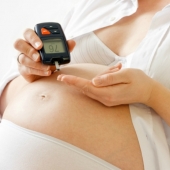Step 1: Decide on a method - Understand what's happening. Each month, an ovary releases an egg -- this process is called ovulation and is accompanied by physical symptoms such as changes in body temperature, cervical mucus, and cervical firmness. Experts recommend tracking at least two symptoms.
Tip: Many factors, including illness, stress, and certain medications, can influence ovulation. For guidance, consult a doctor.
Step 2: Track your basal body temperature - Before you get out of bed in the morning, take your basal body, or resting, temperature for five minutes. Use a thermometer that shows tenths of degrees, and use the same thermometer every day. On your calendar, note the temperature to the nearest tenth.
Tip: Ask your health-care provider for a fertility chart.
Step 3: Examine your cervical mucus - Check for cervical mucus every morning before bathing or urinating. Use clean fingers or a piece of toilet paper and swipe inside the opening of the vagina. On your calendar, note whether you have no mucus, cloudy or yellow mucus that is sticky, or mucus that is clear and stretchy.
Step 4: Check for changes in your cervix - Check for changes in the position and feel of your cervix. Use two clean fingers and gently reach back into your vagina until you can feel the cervix. On your calendar, note whether the cervix is easy or difficult to reach. Also note whether it feels firm, like your nose, or soft, like your lips.
Step 5: Track your symptoms for at least two cycles - Track your symptoms every day for at least two full menstrual cycles. The first day of menstrual flow is considered day one of your cycle.
Tip: You can also buy an over-the-counter ovulation predictor kit, which tests urine for certain hormones.
Step 6: Monitor your temperature - Look at the pattern of your basal body temperature. Your body temperature rises at least one-half degree after ovulation, and remains high until the end of your cycle.
Step 7: Analyze your cervical symptoms - Look at how your cervix changes. Cervical mucus becomes thicker before ovulation, and ovulation has most likely occurred when mucus is slippery and resembles egg whites. The cervix becomes softer and more difficult to reach as ovulation approaches.
Step 8: Look for a pattern - Look for patterns on your calendar or fertility chart. If your cervical mucus becomes clear on the same day your temperature goes up, you’ve most likely ovulated. Familiarize yourself with your body’s pattern, and you can anticipate future cycles and take charge of your fertility.
Did You Know?
A baby girl is born with over one million egg cells. During her lifetime, about 400 of them will develop into eggs and be released during ovulation.
- 557 views













